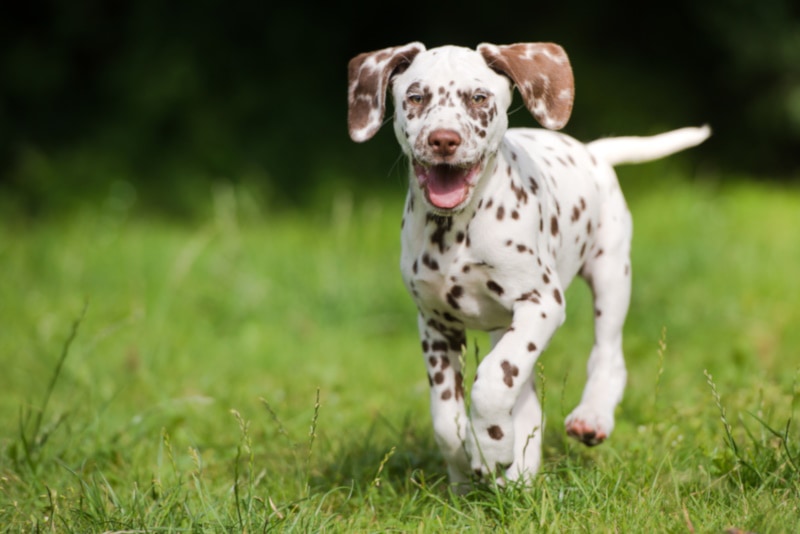The 5 Different Types of American Bulldogs (With Pictures)

Updated on

It seems that many countries have their version of a Bulldog. While each has their own unique build and look, they all share common denominators. You can recognize most Bully breeds by their stout bodies and short muzzles. American Bulldogs, in particular, have developed quite a bit over time, branching off into other subgroups.
When it comes to breeding for specific purposes, a single breed can take on different markings or body structures. Let’s take a look at the five different types of American Bulldogs and learn how they came into existence.
The 5 Types of American Bulldogs
1. Johnson (Bully) American Bulldog

The 100% Johnson American Bulldog comes from the original John D. Johnson breeding lineage. These dogs were bred during the World War II era. They have a classic underbite and boxy skulls, giving them that distinct Bulldog look.
Some consider Johnson American Bulldogs to be the ideal, authentic American Bulldog specimens. This line is stout and heavy. Because of their broad, muscular bodies and short muzzles, they are often confused with other Bully breeds, such as the English Bulldog. They stand between 23 and 27 inches at the shoulder.
They are incredibly protective and pleasing as household companions. Their low activity levels can often lead to laziness and obesity. If you don’t promote an active lifestyle, these dogs are sure to be your napping buddy, relaxing every chance they get. They are friendly and even considered goofballs.
2. Scott (Standard) American Bulldog

The Scott American Bulldog has a different story to tell. They came into fruition as a cross between the Johnson American Bulldog and southern Bulldogs, like the White English. They are known as the standard or performance type because of their power and strength.
This bloodline is much swifter and physically driven than the Johnsons. They are athletically built and have a longer muzzle. They also have long legs, making them tall and lean in stature. They are generally between 22 and 27 inches, at shoulder height. Because they were bred for work, they require a much more stimulating environment.
These dogs are often confused with the American Pit Bull Terrier due to their similar body structure and temperament. Rather than sharing the classic underbite, this line has what is referred to as the reverse scissor bite.
Scotts are better suited for individuals with active lifestyles. If they aren’t mentally and physically stimulated regularly, they can find other ways to fill their time. This typically involves being physically destructive with personal property.
3. Painter (Margentina) American Bulldog
The Painter, or Margentina, American bulldog has a sadder history. These physically capable dogs are made to fight and bred solely for this purpose. They are also considered a performance line, but for more sinister purposes.
They were developed in the 1970s by Joe Painter and several others. Initially, Painter’s litters suffered from severe inbreeding, which led to many complications for the dog overall. However, they began to thrive and rise in popularity over time, thinning out this defect.
It’s believed that somewhere along the way, American Pit Bull Terriers were introduced into the bloodline, though this is not confirmed. These dogs are stocky, responsive, and trainable. They weigh an average of 55 to 75 pounds. So, they are small in stature but bulky all over.
4. Old Southern White American Bulldogs (White English)
It’s been said that Old Southern White American Bulldogs, otherwise known as a White English, are the oldest traced lineage of all. With each other bloodline, it’s believed that these dogs laid the foundation for those that exist today.
While the Old Southern White and the White English are thought of as being the same dog, there are two variants here as well. There are a Bulldog and a Mastiff style, which creates subtle differences in structure that may not be highly noticeable to the untrained eye. These dogs are commonly seen in the South, though they have been fizzling out over time.
Even though they may have been a part of modern lines, they should not partake in breeding with current American Bulldogs. The American Bulldog has come quite far from their beginning points. So, creating a mixture could now create muddied bloodlines and undesirable traits.
5. Hybrid (Multi-line) American Bulldogs

While this isn’t specifically a type individually, many American Bulldogs are considered hybrid lines. That means that breeders use various lines to interbreed, creating a different result. You can get many different body structures, temperaments, capabilities, and characteristics.
The breeder may have a desire to tailor the breed for specific purposes. They could want more of a worker, a companion, a protector, or a watchdog. Breeders can manipulate lines and specify traits exhibited in parents to create ideal specimens for specific roles.
Since hybrids are ever-changing, there are no general rules in terms of size or structure. They can take on various characteristics of any of the lines. You can have a Bully-style hybrid or a sleeker, leaner combination, like the standard lines.
Conclusion
It’s amazing to see how individual breeds can transform and morph over time. American Bulldogs have such a rich history with many stories to tell. They have been used for both honorable and ominous purposes, but this doesn’t take away from the magnificent breed itself.
American Bulldogs have become a competent, structurally striking contribution, adding to the already-impressive Bulldog group. There is so much to love about them, and they have definitely left their mark on American culture.
See Also:
- 14 All-American Dog Breeds (With Pictures)
- Best Dog Foods for American Bulldogs: Reviews & Top Picks
Featured Image Credit: vilinapetrova, Pixabay











